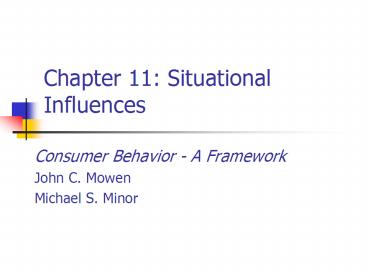Chapter 11: Situational Influences - PowerPoint PPT Presentation
1 / 27
Title:
Chapter 11: Situational Influences
Description:
Manipulation of retail shopping environment to achieve a certain effect. ... Women start shopping earlier for Christmas (October vs. November) ... – PowerPoint PPT presentation
Number of Views:431
Avg rating:3.0/5.0
Title: Chapter 11: Situational Influences
1
Chapter 11 Situational Influences
Consumer Behavior - A Framework
John C. Mowen
Michael S. Minor
2
Key Concepts
- Consumer Situations
- Types of situational influences
- Influence of physical surroundings
- Store location effects
- Store atmosphere
- Task definition
- Categories of gift-giving situations
- Influence of time
- Time differences across cultures
- Types of antecedent states
3
The Environment and the Exchange Process
Cultural Environment
Economic Environment
Subcultural Environment
Regulatory Environment
Group/ family Processes
Situational Influencers
Individual Processes
Buying Unit
Exchange Process
Marketer
4
Consumer Situations
- Temporary environmental factors that form the
context within which a consumer activity occurs
at a particular place and time.
5
Five Types of Consumer Situations
- Physical surroundings
- Social surroundings
- Time
- Task definition
- Antecedent states
6
Physical Surroundings
- The concrete physical and spatial aspects of the
environment that encompass a consumer activity.
7
Effects of Music on Shoppers
- Slower tempo music
- Customers move more slowly
- Stay longer
- Buy more
- Are not conscious of the effects of the music
tempo
8
Effects of Music continued
- Peppy music while waiting
- Louder music
9
The Effects of Crowding on Consumers
- Density
- Crowding
10
Consumer Crowd Behavior
- Crowd Hysteria
- High physiological arousal
- Act on a dominant idea or tendency
- Each person becomes inconspicuous and individual
responsibility is lost.
11
Store Location
- Actual vs. Perceived Distance
- Cognitive maps
- Image transference
12
Store Layout
- Physical organization
- Creates specific traffic patterns
- Assists in presentation of merchandise
- Helps create a particular atmosphere
13
Atmospherics
- Manipulation of retail shopping environment to
achieve a certain effect.
14
Atmospherics and Shopping Behavior
Emotional Response
Atmosphere
Behavior
Influences
Influences
- Layout
- Sounds
- Smells
- Textures
- Building design
- Pleasure/displeasure
- Arousal/boredom
- Time in store
- Affiliation
- Buying
15
Olfactory Cues
- Shoppers perceive higher quality goods in scented
stores. - Odors should be consistent with store offerings.
- These cues are expensive to maintain.
16
Social Surroundings
- Deals with the effects of other people on a
consumer in a consumption situation. - Conformity pressures
17
The Task Definition
- Situational reasons for buying or consuming a
product or service at a particular time and
place. - Usage situations
- Occasion-based marketing
opportunities
18
Gift-Giving Motivations
Low
High
Reciprocity creation
Voluntary
Altruism
Gift Type
Ritual obligation
Love, friendship
Obligatory
Degree of Self-Interest
19
Gift Behavior and Gender
- Women start shopping earlier for Christmas
(October vs. November) - Spend more time shopping/gift (2.4 vs. 2.1 hours)
- Are more successful (fewer of their gifts are
exchanged) - But men spend 50 more/gift.
20
Self-Gifts
- Premeditated, indulgent
- Rewarding an accomplishment, therapy for
disappointment - Materialism
21
Time Individual Differences
Obligatory
- Work
- Necessities
- Housework
- Leisure
Discretionary
22
Cultural Time Differences
- Linear Separable
- Circular Traditional
- Procedural Traditional
23
Time as a Product
- Many Purchases Are Made to Buy Time
- Time as product attribute
- Time-saving as promotional feature
- Time-buying consumer
24
Time as a Situational Variable
- Time available
- Impact on information search
- Time of day
25
Antecedent States
- Temporary physiological and mood states that a
consumer brings to a consumption situation. - Physiological State Hunger
- Mood State Happy feelings.
26
Antecedent States
- Can lead to problem recognition
- Can change the feeling component of hierarchy
of effects - Mood states influence behavior
27
Managerial Implications
- Positioning
- Environment
- Research
- Marketing Mix
- Segmentation

